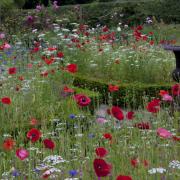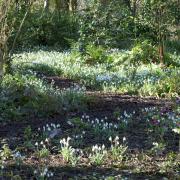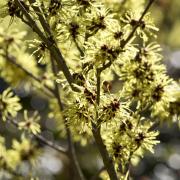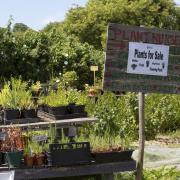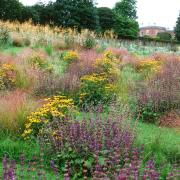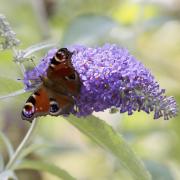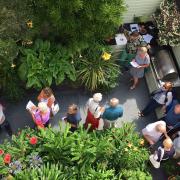Create a cutting garden and you’ll have vases brimming with beauty in the house and plenty to give as gifts

If you love cutting armfuls of fresh flowers and greenery to bring inside but don’t want to spoil the display in your garden beds and borders, creating a separate cutting garden is the solution.
Growing your own cut flowers is both good for the environment, cutting down ‘flower-miles’, and easier on your purse. Now is a great time to prepare an area in your own garden and begin the process.
Choose flowers and foliage that are easy to grow, good value, are bountiful and look as good in the ground as they do in a vase.
Not only will you have the opportunity to try a wide range of options to brighten up your home, you can make up hand-tied bouquets as gifts and your little patch will also be a boon for wildlife, attracting insects on the hunt for nectar and pollen.

Select a sunny, sheltered spot with well-drained fertile soil and prepare it well. A vegetable garden is a great place to grow flowers for cutting and also attracting beneficial insects.
Raised beds are an idea for ease of maintenance and to allow a depth of good soil. Remove all weeds, add in organic matter and rake the soil to a fine tilth. Keep in mind the end result and select flowers you love, have different shapes and textures, long, straight stems, some with scent, and even the colour scheme you want to complement inside.
Growing from seed is the most economical choice and if you stagger sowings you will have blooms through the year.
Do some planning now to ensure a varied production – whether simple and architectural shapes or country abundance with old-fashioned favourites.

It is best to grow a mix of hardy and half-hardy annuals and biennials, with perennials as the backbone to your supply. Plant flowers close together or put in supports ready to stop tall plants flopping over as they grow.
For a year-round supply you could have options such as hellebores, spring bulbs, aquilegia, wallflowers, pinks, sweet William, peonies, alstroemeria, sunflowers, dahlias, asters, chrysanthemums, kniphofias to daphne in winter.
Expert tips

Professional flower grower Bek Bibby of Blooming Green in Linton (where you can buy glorious cut flowers and also attend one of their courses on arranging or growing flowers at home), offers some advice.
“Always plant more foliage and fillers than you think you will need as using plenty of greenery in your arrangements will make them look more natural and rustic. Get inspiration from the garden border or field side and look how flowers grow, keeping the image in mind when arranging.”
Garden designer Hannah Miles-Watson, inspired by Blooming Green, also grows an array of seasonal flowers from her cut flower farm in Benenden and holds bespoke workshops on a range of topics, including starting a cutting garden.
On two-thirds of an acre she produces spring and summer bulbs, some 90 different annuals, roses, peonies and perennials. From early narcissi through to dahlias and late chrysanthemums, there is something in flower from February to December.

“Some must-grow annuals are ammi, antirrhinum and I love the calendula group as it’s so easy. I grow in both rows and patches and add more annuals in between perennials and shrubs, for example my roses are surrounded by nigella. I’d recommend Rosa ‘Chris Beardshaw’, I put in 20 last year, they are repeat-flowering with huge, soft pink blooms and a delicious scent,” says Hannah.
Hopefully you now feel inspired to have a go yourself at home – do send us pictures of your efforts and don’t forget to enter our Kent Life Garden Competition this year.
Cutting tips

Harvest in the coolest part of the day, early morning or late evening
Use a clean, sharp knife or secateurs
Different types of flowers are harvested at appropriate stages in their development. Flowers with multiple buds on each stem should have at least one bud showing colour and one bud starting to open before being cut. Flowers that grow on individual stems should be cut when open
Condition the flowers by placing as you cut into a bucket of lukewarm water and leave in a cool place for a few hours or overnight
If the cut flowers are of different sizes have two buckets – one for large, one for small
Remove lower foliage that will be under water in the vase
Ensure your vase is clean, then recut stems at a 45-degree angle and arrange
Always use tepid water in your vases to avoid air bubbles in the stems, except for daffodils and tulips which prefer cold water
Home made flower preservative can be added to the water - 1 tspn sugar, 1 tspn bleach, 2 tspns lemon juice to approx. one litre of water
Change the water frequently and re-cut stems if flowers start to wilt
Keep away from fruit, which releases ethylene, a gas that causes flowers to age faster
Gardens to visit with cutting gardens
• Godinton House and Gardens, Ashford TN23 3BP www.godinton house.co.uk
• Chilham Castle, Canterbury CT4 8DB www.ngs.org.uk
• Orchard House, Spenny Lane, TN12 9PJ www.ngs.org.uk
10 flowers to sow March-May
• Alchemilla mollis – fresh green foliage and frothy clusters of tiny flowers
• Ammi majus – posh cow parsley, long vase life
• Antirrhinum – colourful varieties, long lasting
• Cleome – white, pink or mauve, long flowering
• Cornflower – clear blue wildflowers
• Cosmos – clouds of cheerful open flowers last until the first frosts
• Linaria – long-flowering season, the more you cut the more flowers grow
• Rudbeckia – late summer and autumn blooms in vibrant yellow or red
• Scabious – pin-cushion flowers, pretty colours
• Sweet peas – cut-and-come-again flowers, hard to beat for scent
Get the look
• A cutting garden is for harvesting so it won’t look pristine at all times
• Grow a range of types: bold, spiky, wispy
• Use it to experiment with new plants and colours
• Mix sizes, shapes, textures
• Include focal flowers and fillers
• Foliage is important eg unusual options; ferns and ornamental grasses
• The less you dig over the soil, the less weeds are disturbed
• Can grow in rows like traditional vegetable plots for ease of maintenance and access
• Plant spring, summer and autumn blooms
• Cutting encourages more flowers to grow
• Include herbs for scent
• Let some of your flowers set seed and collect to sow next year
Plant of the month
Erythronium ‘Pagoda’
• Dog’s tooth violet
• Each stem carries up to 10 nodding yellow flowers
• showy glossy foliage
Growing notes
• fully hardy bulbous perennial
• easy to grow in part-shade
• fertile, humus-rich, free draining soil that doesn’t dry out
• plant in naturalised drifts
• propagate by division after flowering
• multiplies and grows strongly with the right conditions
• dies down after flowering and re-appears the following spring
Jobs to be done
• With spring’s energy new and fresh, it’s an excellent time to plant, spring clean your garden and take inspiration from visiting gardens
• Tasks include weeding, clearing paths, digging over borders incorporating organic matter and cleaning tools
• You may like to make your own plant supports with hazel and birch twigs
• Plant summer flowering bulbs, such as flamboyant gladioli and lilies
• Cut down perennials and grasses that have been left for winter interest
• Give the lawn its first cut with blades on the highest setting
• Start to sow carrots, lettuce and radishes, plant asparagus crowns, onions and shallot sets
Find out more
Cut flower growers with workshops
• Blooming Green, Linton ME17 4AG
Seed-sowing workshop 10 March (10am-12pm), £35
Planting and no-dig workshop, 25 May (10am-12pm), £35
Booking essential: www.bloominggreenflowers.co.uk
• Hannah’s Garden, Benenden TN17 4EU
Tailor-made workshops include starting a cutting garden
Day’s workshop £250, includes lunch, for up to four people






